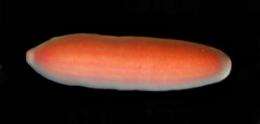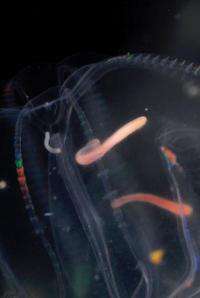New parasite could be late summer beach pest

Researchers at the University of Gothenburg have discovered a new sea anemone that is thought to have established itself in Swedish waters. Larvae from similar anemones causes skin problems for sea bathers in the USA.
Researchers at the Department of Marine Ecology at the University of Gothenburg have been following the invasion of the American comb jellyfish, Mnemiopsis, for several years. They have now discovered that it contains larvae from another species: a sea anemone that lives on it as a parasite. According to the researchers, this could be the same parasite that causes skin rashes on sea bathers in the USA.
The sea anemone, which the Gothenburg researchers believe to have identified through DNA analysis as Edwardsiella, is common in the comb jellyfish's natural environment in the West Atlantic, but has not previously been found in Swedish waters or anywhere else that the comb jellyfish has spread to. It is the sea anemone's larvae which live as parasites on the jellyfish, and which cause skin irritation in humans - and these may be problematic for Swedish sea bathers too.
"The American variety of the sea anemone causes a skin complaint known as sea bather's eruption, which doesn't generally require treatment, but takes the form of quite a nasty rash that lasts for a few days," says researcher Erik Selander. "But the anemone we have found is confusingly similar to a Swedish anemone called Edwardsiella carnea, and we won't know which of the two species it is, or whether there actually are two species involved, until we have carried out further genetic analysis.
"If it is the American Edwardsiella that has come here, we could see isolated cases of sea bather's eruption here in Sweden too as we move towards autumn," believes Selander.

"However, we haven't seen the extreme numbers of the species in Swedish waters that are present on the American east coast. The anemone larvae also peak in September, after the high season for Swedish bathers."
Erik Selander and his colleagues recorded the parasite during two separate surveys in 2007 and 2008. In the latter, parasite numbers had increased to 40 per of the comb jellyfish numbers. From an ecological point of view, the finding is therefore not an entirely bad thing.
"The explosive increase in numbers of comb jellyfish here and in the Black Sea, for example, is thought to be down to the fact that the jellyfish has fewer natural predators here than in its natural environment," says Selander. "It is therefore particularly exciting to see what will happen now that a natural predator has shown up. Given that there are so many parasites, it is hoped that they can help suppress the invasion of the jellyfish somewhat, as it seems to do on the other side of the Atlantic."
More information: The article 'Parasitic anemone infects the invasive ctenophore Mnemiopsis leidyi in the North East Atlantic' was published in the May edition of the journal Biological Invasions.
Provided by University of Gothenburg


















